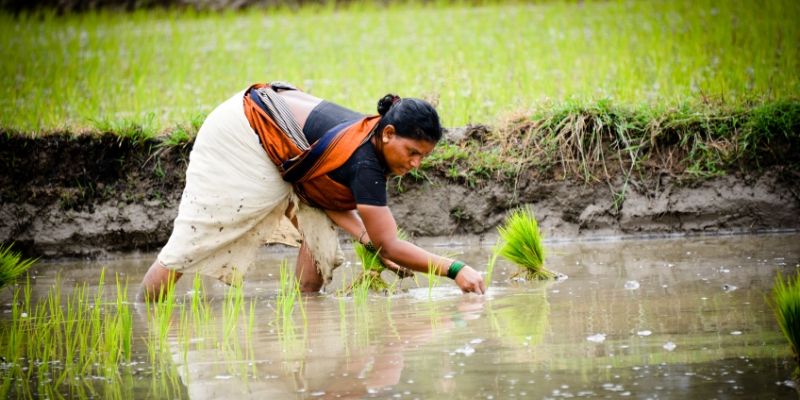Indian agriculture needs to adapt innovations to become sustainable and profitable for farmers. There are multiple challenges facing Indian agriculture, including climate change, water stress, deterioration of soil health, price volatility, and farmer’s lack of motivation to continue farming.
There are estimated about 150 million farmers in India with a majority of them (more than 85 percent) owning less than two hectares of farmland. A farmer with average land holding of about one hectare earns a gross income of about Rs 100,000 to meet his personal, family, and occupational needs.
As a result, farmers are often left with little surplus for productive investment for new-age solutions.
But, as demonstrated by over 600 agritech startups, innovations can go a long way in improving farm economics with improved yield, reduced cost of inputs and empowering farmers to de-risk against commodity price fluctuations, monsoon failures etc.
A growing breed of agri-entrepreneurs is working towards improving farmer access to markets, quality inputs, institutional credit, and insurance.
Consumers also benefit in the process with improved access to safe, nutritious and affordable food. Industry and government gain with access to reliable, timely and accurate data for decision making and policy design for farmer welfare.
There have been several efforts at the central government as well as some state governments to take these innovations to farmers. In addition, there is effort made by some of the Foundations and not-for-profit enterprises to support technologies which positively impact smallholder farmers.
All these efforts are welcome signs. However, a coordinated and synergistic approach can go a long way to amplify the positive impact on farm economics.
It is time the government drives the innovation agenda parallel to other agri reforms to make the impact of reforms more productive. This article talks about the current startup ecosystem in Indian agriculture and needs for enabling policy framework.

Current status of startups in agricultural space in India
The agritech sector took its root in the last decade however it gained momentum in the last three years, driven by the entry of high-quality entrepreneurs and increasing investor interest.
There are estimated more than 600 post POC (Proof-of-Concept) agritech startups in the agricultural sector, most of them with a vintage of less than five years.
Investors have pumped in close to $1 billion in upstream agritech deals over last decade and the momentum has started to pick up with over $600 million invested in the last 24 months.
In all probability, agritech will continue to attract venture capital in the range of $500 million to $ 1billion on annual basis in the foreseeable future.
Indian agritech startups are trying to solve multi-dimensional problems prevalent in Indian agriculture including low productivity, sub-optimal efficiency in the supply chain, and lack of access to markets, institutional credit, crop insurance, quality inputs and market linkages.
The top seven emerging innovation themes in Indian agriculture, horticulture and livestock are as follows:
Demand drive and tech-enabled aggregation and distribution of farm produce from point of collection to consumption (examples: Ninjacart, Jumbotail, Bigbasket, Kamatan, Desai Fruits Venture, Farmlink, WayCool, MeraKisan, Kamatan, DeHaat, ShopKirana, SuperZop, Agrowave, Crofarm, Agribolo, Himkara, Kisan Network, Milklane, Fresh to home, Licious, Numer8, AquaConnect, City Mandi)
Quality assaying of agricultural commodities through image processing and digitisation of transactional data, price discovery and traceability (examples: Intellolabs, Agricxlab, qZense, Raav Tech, InfyUlabs, Lateral Praxis, Occipetal, Amvicube, Nanopix, TraceX, Source Trace, Atsuya Technologies)
Building near-farm storage, warehouse and processing units with access to post-harvest finance and market linkage through digital and physical modes (examples: Our Foods, S4S Technologies, Agri Bazaar, Star Agri, Arya Collateral, Ecozen, Origo, Sohan Lal Commodites, Promethean, Inficold, Whrrl)
Optimise the use of agricultural inputs and enable delivery to farmers based on farm and crop diagnostics (examples: Agrostar, BigHaat, Behtar Zindagi, Unnati, Gramophone, Freshokartz, AgriBolo, Plantix, Helicrofter, Hesa, EF Polymer, Frontier Markets, Bharat Rohan, Bharat Agri, E Fasal)
Reduce labour cost through mechanisation on the pay-per-use model and innovative mechanical tools (examples: Sickle innovations, Distinct Horizon, Kamal Kisan, Mera Tractor, Cellestial Tractors, X-Machines, Tractor Junction, Khetibadi, EM3, Agrirain, Flybird, Toolsvilla)
Farmer advisory and data-driven crop monitoring/precision farming/lending (examples: CropIn, SatSure, Mantle Labs, AgRisk, Skymet. Samunnati, Samaaru, FarMart, Jai-Kisan, PayAgri, Bijak )
Environment-controlled agriculture using techniques such as vertical farming, hydroponics, aquaponics (examples: Futurefarms, Urban Kisaan, Absolute Foods, Kaze Living)
Its early days but there is a strong probability of convergence of above themes to build scale and optimise the cost of farmer access. Policy can be a significant enabler in this process as strong public ecosystem creation would significantly improve returns for the private capital to chip in.

Policy prescription for Indian agritech
The Indian agritech has demonstrated benefits to farmers and value chain players. However, the penetration of agritech solutions remains below 10 percent with about 14 million farmers adopting available agritech solutions.
It’s time to democratise the agritech solutions among larger farmer community with enabling policy framework to make Indian agriculture sustainable, market-driven, climate-resilient and efficient.
Another key impact which agritech models are likely to achieve is creating millions of jobs in rural areas, which is one of the government’s key priorities.
In order to achieve this vision, there is need to build a thriving entrepreneurial ecosystem including policymakers, financial institutions, think tanks, academia, industry, FPOs, farmer bodies, startups and investors in agriculture space to drive adoption of innovations in all aspects of Indian agriculture.
Here is 10 point policy prescription for Indian agritech:
Build a sandbox for agri-fintech solutions
The cost of capital in Indian agriculture is prohibitively high from farming to processing to distribution. Despite the government’s $180 billion target for priority sector lending (PSL) to agriculture, about 70 percent of farmers do not have access to institutional credit, paying interest of 24 percent to 60 percent per annum (against 7 percent under PSL).
Likewise, MSMEs including warehousing companies, processors and distributors which dominate the food supply chain pay the high cost of working capital (15 to 18 percent).
The high cost of capital makes farming and value chain businesses unviable. Digitisation of food supply can make the data available to bankers, which can reduce banker’s risk and cost of capital. Many agritech and fintech startups are working in digitising the supply chain to help bankers lend intelligently.
We need a dedicated sandbox where both public and private sector banks can be incentivised to work with startups for building and piloting innovative agri / fintech solutions to scale them faster.
Develop climate-finance products
India is amongst the most water-stressed and climate-vulnerable countries in the world. A large part of
Indian arable land can go dry in the next decade or so if we do not pay attention to it. Solving for climate risk needs a holistic, collaborative approach through policy intervention, investment and innovation.
Indian agri tech community in the last few years that are trying to address climate change risks including building climate-predictive data-driven models, solutions for resource conservation and reducing carbon footprints.
However, the big question is why a farmer would adopt these practices. One option is to build credit and insurance products that incentivises farmers to adopt climate-resilient solutions.
The incentives to farmers could be in the form of interest subvention and reduce the premium on loan and insurance products respectively. Regulators need to work with banks, insurance companies and startups to conceive such products.

Image Source: Shutterstock
Dedicated cell for agritech startups
Agritech startups often struggle to reach out to bureaucracy and policymakers, specifically at the state level. For example, the current laws do not recognise agri-input ecommerce platforms for the purpose of distribution and storage of agri inputs such as seeds, fertilisers and agrochemicals.
Startups in this space often find it difficult to expand their footprint because of a lack of regulatory clarity on agri input ecommerce. A dedicated cell at the state level would go a long way in facilitating continuous dialogue between the state government and the startups.
Likewise, there are many other areas where such a dedicated cell under the aegis of central / state governments can play a proactive role to help agritech startups.
Three such areas are:
1. State governments through state agricultural universities and research centres can support startups for pilots and validation of technology. The validation from universities will help startups in course correction as well as in approaching the potential customers.
2. State governments can also play an important role in training and capacity building of village-level entrepreneurs who can act as channel partners for agritech startups to make their innovations accessible to farmers in the state.
3. Another area which this cell can focus on is building high-quality research papers related to innovations happening in India by startups in the field of agriculture. There are multiple areas which need in-depth research, for example:
- How innovations are impacting the farmer’s income?
- What are the challenges in farmer adoption of new-age technologies?
- What innovations in financing are needed to improve lending to smallholder farmers?
- What are the challenges in creating a pan-India market for agri commodities?
There is a long list of research areas and many unproven hypotheses. Lack of well-researched data makes decision making sub-optimal for policymakers, investors and entrepreneurs. The dissemination of research and knowledge can be done through workshops, reports, events as appropriate.
Centre of excellence for data science applications in agriculture
The secret sauce of data-centric models in agritech lies in building machine learning and artificial intelligence (AI) models, which can predict events in advance with more accuracy such as any weather event, pest attack, harvest and crop yield, commodity prices.
AI models also provide immediate, low cost, affordable portable, accurate solutions for the measurement of soil moisture, nutrition, crop health, quality assessment etc.
One of the biggest challenges in scaling AI models is the lack of access to good quality data. Most startups spend disproportionate effort and time on data collection rather than the effort needed for data modelling.
The government can attempt to build a public data repositories by collating already existing datasets that lie with government departments, research institutions and universities.

Piloting Agristack
Agristack is conceptualised as a public digital platform for ready, authenticated and almost instant access to farmers. This platform can be the hotbed for driving disruptive innovations in the agricultural sector.
The Government of India has already initiated work on AgriStack, under IndEA framework, called IndEA Digital Ecosystem in Agriculture (IDEA). Ministry of Electronics and IT along with the Ministry of Agriculture are working on it.
Building AgriStack has to be a collaborative effort including governments (both federal and state) along with innovators. Use of technology in developing Agristack can optimise time and cost involved.
There is clearly a one-time investment in building this and then there will be a recurring cost to maintain and continuously update it. Unlike IndiaStack, AgriStack will have dynamicity given multiple crop cycles and changes in farm boundaries over a period of time.
It is time for piloting multiple Agristack to formulate, test, design and build architecture; guidelines and modus operandi. Startups working on building digital tools such as satellite imagery, drones for mapping farms can develop relevant tech models.
Ground truthing support for the purpose of identifying, validating and tagging cultivators/farmers to a farm needs to be provided and validated by the state governments.
The utility of the AgriStack once developed can be tested by inviting partners including banks, insurance companies, agri input and output companies and anyone who wants to build first and last-mile access to the farmers. It is imperative that we need to make the platform open-source to maximise its utility. The extent of access needs to be discussed and decided jointly with the respective state governments.
Building incubation support for rural India
The significance of agribusiness incubation Centres in facilitating an ecosystem conducive for the growth of agribusiness enterprises is recognised worldwide. In India too, the work done by incubators such as CIIE.CO, Indigram Labs, A-Idea Naarm, Pusa Krishi, ICRISAT, Villgro, and many others are exemplary, in nurturing hundreds of agri entrepreneurs.
It’s now time to build rural incubators to motivate and support rural youth to build their own entrepreneurial models.
The state agricultural universities and Krishi Vigyan Kendras can be roped in to build such incubators. The government should lay down guidelines for selection of incubators, locations and provide support for training the incubator managers with a focus on rural areas. Rural incubation models will truly democratise the startup ecosystem in India.
Catalytic funding for young agritech startups
Though the government of India is already investing in multiple startups through government-supported incubators, we still need a high-velocity catalytic fund for investments at the seed stage. There is enough depth in the ecosystem to absorb seed funding in the tune of Rs. 100 crores per annum, supporting about 50 to 100 startups every year.
This will not just accelerate the proofing of concept, product and market development but will also facilitate the pipeline for the flow of capital into agritech ecosystem for the late-stage funds.
Incorporating agri entrepreneurship courses in agricultural education
The agritech sector needs top-quality talent for scaling the models. There is a need for nurturing talent at the college/university level itself. This can be made possible by incorporating courses on entrepreneurship in all agricultural streams.
Also given huge application of data sciences in new-age models, a few courses on data analytics and machine learning could be made part of the curriculum. Internship with agritech startups could be another way to familiarise young graduates with startup culture.
Platform for startup – FPO – MSME connect
Evolution of Farmer Produce Organisations (FPOs) in India is at a nascent stage. FPOs are filling important gaps in the supply chain with a focus on aggregation of farm produce and linking farmers to markets. There are about 7000 FPOs in India, but only a few have reached scale and commercial viability.
FPOs in order to be successful need support in the form of financing, credit rating, capacity building, warehousing, primary processing etc.
Startups are best placed to build tailor-made solutions for FPOs in all these areas. We are already seeing many startups orienting their business models to cater to the needs of FPOs. The handshake between farmer and agritech entrepreneur will create unique win-win collaborative business models and FPOs have a huge role to play in making this happen.
Lead institutions like NABARD and SFAC can take the lead for coordinating partnership between startups and FPOs.
Likewise, there is hardly any interface between MSMEs and startups despite the fact both agri input and post-harvest supply chains are dominated by MSMEs. Many MSMEs can optimise their cost of sourcing and improve value addition in partnership with agritech startups.
Governments can facilitate dialogues and partnerships between FPOs, MSMEs and startups.
Tech integration in export linked supply chains
India’s exports of food and agricultural products are about $ 30-35 bn per annum. For India to meet its export target of $ 100 bn, it needs to integrate technologies related to quality assaying, certification, traceability, food safety and price discovery for building access and trust among importers.
There are enough tech solutions developed by startups which can solve challenges faced by the exporters. Agencies like APEDA can facilitate continuous interactions, dialogue and pilots between the startups and exporter of food products.
To conclude, the above 10-point policy prescriptions can be a game-changer for Indian agritech, which in turn can benefit millions of farmers.
It also complements the government’s agri reform agenda. The multiplier impact of scaling agritech on the rural economy could be huge in terms of creating jobs and providing livelihoods to rural youth.
The marriage of agri reforms with agritech innovations is the perfect recipe for the longevity and sustainability of Indian agriculture.
Edited by Saheli Sen Gupta
Link : https://yourstory.com/2021/01/policy-push-indian-agritech-startups-investment
Author :- Hemendra Mathur ( )
January 10, 2021 at 02:08PM
YourStory





